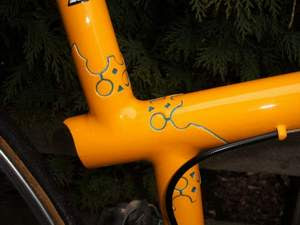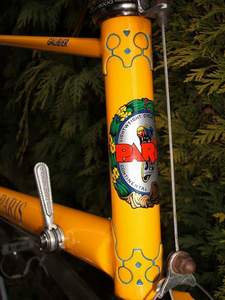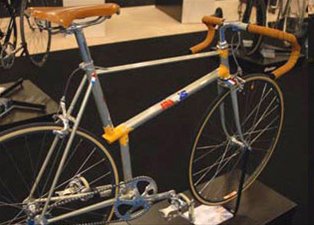The Paris Galibier
 Mon, February 4, 2019
Mon, February 4, 2019
 In 1950 as a 14 year old, I attended Luton Technical School, some 30 miles north of London, England. Adjacent to that school was a Technical College for older engineering students. Many of these students were racing cyclists and would leave their bikes in the bicycle rack in the school yard.
In 1950 as a 14 year old, I attended Luton Technical School, some 30 miles north of London, England. Adjacent to that school was a Technical College for older engineering students. Many of these students were racing cyclists and would leave their bikes in the bicycle rack in the school yard.
Lunch time would find me scrutinizing every fine detail of these bikes; it was the beginning of love affair with the bicycle that ultimately shaped my life, and lead to a career as a framebuilder.
 One of the most unusual and eye-catching bikes was the Paris “Galibier” model. Paris was the brand name of London framebuilder, Harry “Spanner” Rensch.
One of the most unusual and eye-catching bikes was the Paris “Galibier” model. Paris was the brand name of London framebuilder, Harry “Spanner” Rensch.
His last name sounded like Wrench, hence the nickname “Spanner.” During WWII Rensch was an oxy-acetylene welder in London’s shipyards.
Paris Cycles started during the war in 1943. Harry probably chose the name Paris rather than use his own German sounding name, because of obvious wartime anti-German feeling, especially after the London Blitz.
He used a “Bi-laminated” construction for his frames that is a sleeve brazed over the ends of the tubes, and the actual joint then filet brazed. Referred to as “Bronze Welding” in the Paris literature.

Beside the Galibier model, Harry Rensch also built conventionally designed frames. The most popular of which was the “Tour de France” model. (Above.)
Paris frames often sported very flashy paint jobs, especially for that time. I remember red, white, and blue fade paint for example. There was a large Eiffel Tower decal on the seat tube, and the Paris name was stenciled on the down tube.

Ever since the introduction of the Galibier, and to this day, many a fierce argument has been held over this style guru’s dream machine. Is it just a style gimmick or is there real merit in this design?
I never rode a Galibier, but I will say this, a bicycle frame twists as it is being ridden, about a line from the head tube to the rear dropout. So placing a single large tube along this line, (Or there abouts.) does have merit. The seat tube is also split to form an interesting cantilever design.
One thing cannot be denied is the superb craftsmanship of Harry Rensch. Like many artists before and since, Rensch was not a good businessman. Paris Cycles was always plagued with financial problems, and lasted just 10 years, closing their doors in 1953. Harry Rensch never returned to the bicycle business and died in 1984. The Galibier is his legacy.

In recent years Condor Cycles in London bought the rights to the Paris name and are reproducing the Galibier model. (Picture above.)
Pictures from Classic Lightweights, UK




















Reader Comments (6)
It may be a great ride, but it just doesn't look right. Looks broken :-)
I was at Condor Cycles in London recently and there is one on display. Probably the same as one as I bet they don’t sell many. Dave Yates, English semi-retired frame builder once had the contract to build these frames for Condor. He said they were awful to ride and flexed terribly. Still, at least the Galibier makes other alternative classic frame designs, like the ‘flying gate’ and the curly Hetchins look positively normal in comparison (and both are still made today, though not by the original makers).
K.I.S.S.
Simple, succinct, secret of good engineering practice. This is not an example of that.
It is an example of deductive reasoning, not inductive. In other words, finding evidence to support a conclusion, in this case you come up with reasons for such a build.
Oh well, it is creative, if that’s all you want in a bike.
I rode once,a ""flying gate" bike was not impressed, very squirly Just like Hetchins curly when climbing a hairpin on a mountain pass. GIMMICKS to say the least
Looking at the two designs, The Flying gate is the better. But even that was not to my liking. Would like to ride the Galibier sometime to compare
I have my late father’s original Paris Galibier cycle that he purchased new from Harry Rensch in the early 50’s I understand.
It’s in my loft gathering dust.
Don’t really know what to do with it?